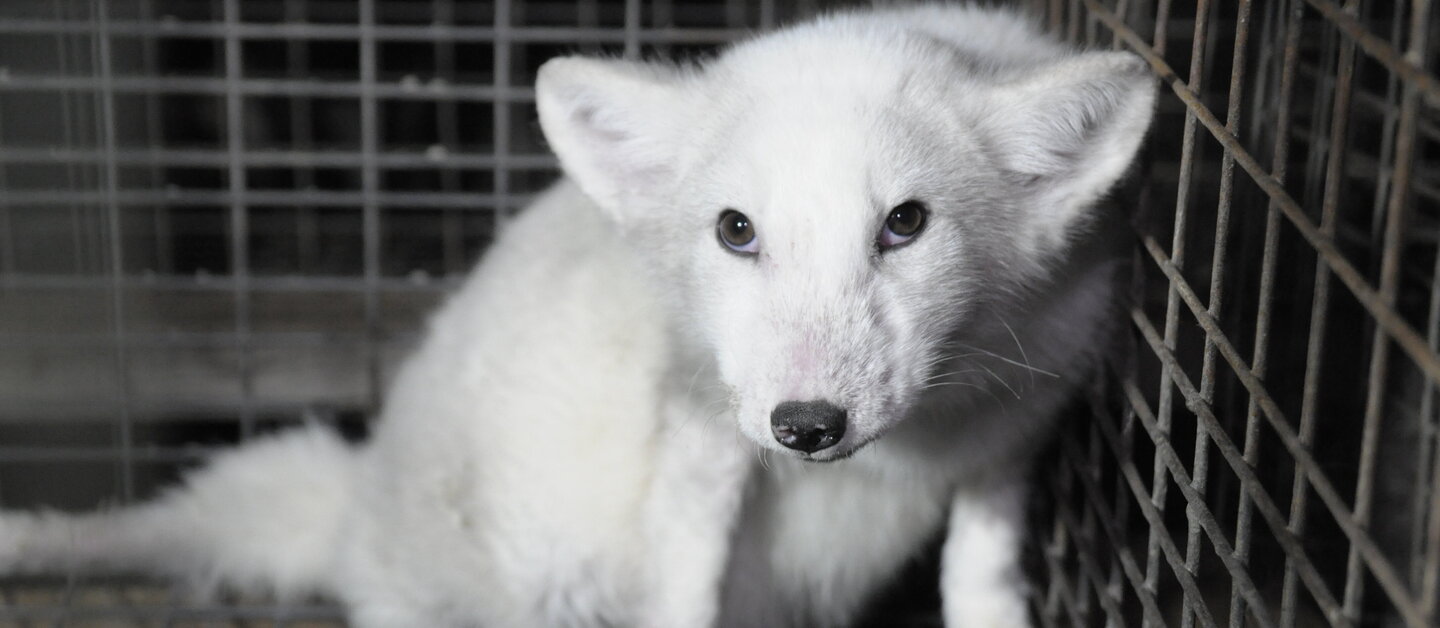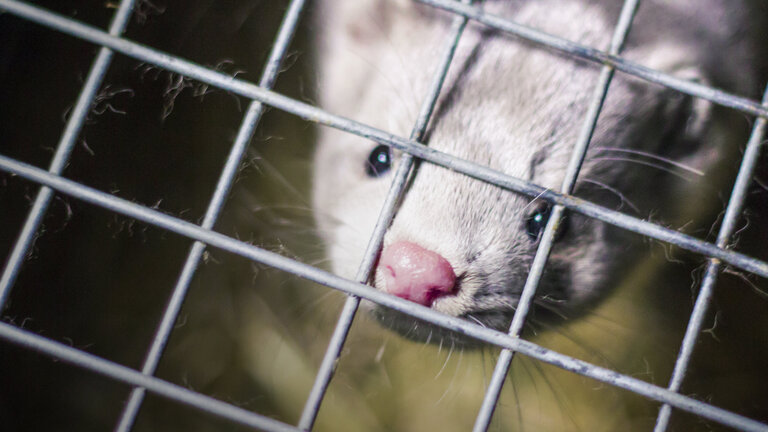Cruel conditions on fur farmsMillions of animals suffer and die for fur
Every year, around 100 million animals such as minks, foxes, raccoon dogs, chinchillas and rabbits die for the fur industry worldwide. But fur farmers keep the still staggering number of animals in cramped wire cages made of gratings and kill them brutally. Any garments made from or with fur cause incredible animal suffering.
Fur coats are now frowned upon by society. But all the more people wear the unnecessary real fur as hood collars, hat pompoms or as trimmings on gloves and bags. Fur can be seen everywhere, especially in winter. The fashion industry switched to accessories and optical embellishments made of fur years ago, which is why the fur trade is still a lucrative business. Not all buyers are aware that animals suffer and die for the fur that is attached to jackets and the like - even for inexpensive items of clothing. The German Animal Welfare Federation has been campaigning against these abuses for many years.
Cage farming is unacceptable
Millions of minks, raccoon dogs, chinchillas, nutrias, sables, polecats, silver and blue foxes vegetate in fur farms every year. The animals are crammed into tiny wire cages next to each other in very confined spaces. Their droppings fall through the mesh floor and collect under the cages. The animals therefore sit directly above their excrement. These unacceptable conditions do not even begin to meet the animals' minimum requirements. Minks, for example, cannot bathe, foxes cannot dig and chinchillas cannot live out their complex social behavior. Massive behavioral disorders are the result: the animals constantly run back and forth, for example, while older breeding minks hardly move at all. Grid, fur and tail biting or tail sucking often occur until infected wounds develop and the animals lose limbs. Some mother animals eat their own young. At the end of a short, sad life comes the killing: minks are gassed, foxes or raccoon dogs are usually killed by anal electric shocks.
Fur farms are widespread worldwide
95 percent of fur products come from fur farms. China is currently the largest producer of mink, fox and raccoon dog fur. There were over 750 fur farms in Europe in 2020, but there are probably even fewer today due to many closures during the coronavirus pandemic. After Denmark culling more than 15 million mink due to the pandemic, Poland is now the largest mink producer in Europe. Finland has the farms with the largest fox populations and, together with Poland, is also the European leader in raccoon dogs. Chinchillas are particularly common on fur farms in Denmark, Poland and the Balkans. Fortunately, however, there are many European countries where fur farms are now banned. These include Belgium, Bosnia, Estonia, France, Great Britain, Ireland, Italy, Croatia, Latvia, Luxembourg, Malta, Macedonia, the Netherlands, Norway, Austria, Serbia, Slovakia, Slovenia and the Czech Republic. There are currently no more fur farms in Germany . Although there is no ban, the farms have stopped production due to stricter regulations. The last mink farm in Germany closed at the beginning of 2019.
Agonizing trap hunt
In the wild, animals such as red foxes, coyotes, wild rabbits, martens and raccoons are still caught for their fur using various traps for fur production. Trapping irons, for example, consist of catching bars that trap the animals and seriously injure them as soon as they come into contact with them. The animals often struggle for hours or even days in pain to survive. In futile attempts to free themselves, they tear deep wounds, dislocate or break their limbs. Some animals even bite off their trapped paws out of sheer desperation.
Fur Free Alliance
Since 2014, the German Animal Welfare Federation has been a member of the Fur Free Alliance - an association of international organizations that campaign against animal suffering in fur production. Among other things, this alliance has promoted the European citizens' initiative #FurFreeEurope, which calls for an EU-wide ban on fur farms and a trade ban on products from fur farming. Over 1.5 million valid signatures were collected within a very short space of time.1 The EU Commission was therefore obliged to respond. In December 2023, the EU Commission decided to first conduct further investigations into fur farms instead of tackling a ban on fur farming and the marketing of fur in the EU in the near future.2

How do I recognize fur?
The labeling of fur products is completely inadequate and often incorrect. Consumers have hardly any chance of distinguishing between real and synthetic fur products on the basis of a label. In addition, the fur industry uses incomprehensible terms to disguise which animal actually died for the garment. You can find an overview of the camouflage names here.
Regardless of the labeling, it is not easy to distinguish between real and fake fur. However, a few pointers can help. Real fur is shinier than fake fur - but a visual assessment is very vague. If you blow into the fur, real hair moves more easily in the wind than somewhat stiffer synthetic hair. A fire test can also provide an indication. To do this, pluck off a few hairs and light them on fire. If it smells of burnt horn and the hair disintegrates into ash, then it is real. Synthetic hair smells chemically like burnt plastic and a small lump remains. You can also check the base. If leather can be seen when the hair is unfolded, it is most likely real fur. Final certainty can only be provided by institutes using genetic tests for animal hair.
Fur-free brands
You can find out which brands around the world do not use fur on the Fur Free Retailer website. This program informs consumers about the fur policy of fashion companies and tries to convince more and more retailers to make their product range fur-free. Fur Free Retailer is an initiative of the Fur Free Alliance.
What you can do
- Do not buy any fur products.
- Generally avoid all products that contain fur - whether artificial or real fur. This is because real fur is not always immediately recognizable and the labelling is also very opaque. Even supposedly fake fur can come from animals, as the production of artificial fur is too expensive for many companies.
- Make your family, acquaintances and friends aware of the animal welfare problem. If more and more people take an active stand against fur, this is an important contribution to taking action against the fur industry.
- Ask stores and online retailers whether they sell real fur and protest against it if necessary.
- Appeal to political leaders in Germany and the EU to ban cruel trapping and obtain a Europe-wide ban on fur farming and the fur trade.
Sources and further information
1 Press release of the German Animal Welfare Federation dated 02.03.2023 "Fur Free Europe: More than 1.7 million votes for a fur-free Europe"
2 Press release of the German Animal Welfare Federation dated 08.02.2023 "No ban on fur farms in Europe foreseeable"








